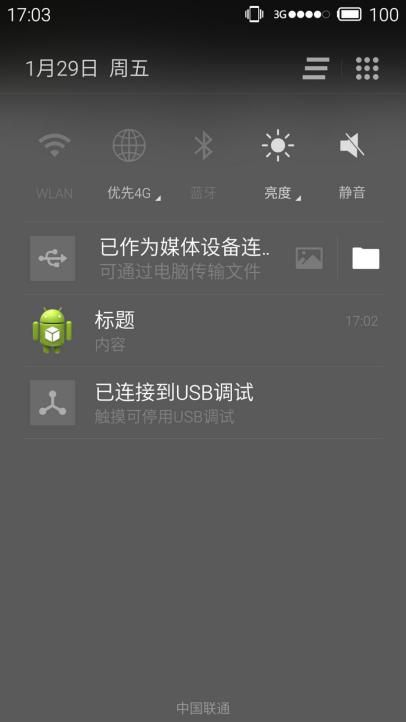RemoteViews在桌面小部件和通知栏的使用
(《Android开发艺术探索》读书笔记)
什么是RemoteViews:
它所表示的是一个View结构,可以在其他进程中显示,也就是可以跨进程更新它的界面。
RemoteViews的应用场景:
通知栏和桌面小部件(都运行在系统的SystemServer进程)。
首先说明桌面小部件的开发步骤:
1、定义小部件界面:
/桌面小部件/res/layout/widget.xml
<LinearLayout xmlns:android="http://schemas.android.com/apk/res/android"
android:layout_width="match_parent"
android:layout_height="match_parent"
android:orientation="vertical" >
<ImageView
android:id="@+id/iv_img"
android:layout_width="wrap_content"
android:layout_height="wrap_content"
android:src="@drawable/ic_launcher" />
LinearLayout>
2、定义小部件配置信息:
/桌面小部件/res/xml/appwidget_provider_info.xml
<appwidget-provider xmlns:android="http://schemas.android.com/apk/res/android"
android:initialLayout="@layout/widget"
android:minHeight="84dp"
android:minWidth="84dp"
android:updatePeriodMillis="86400000" >
appwidget-provider>3、定义小部件的实现类:
/桌面小部件/src/com/example/remoteviews/MyAppWidgetProvider.java
/**
* 桌面小部件演示
* @author Administrator
*
*/
public class MyAppWidgetProvider extends AppWidgetProvider {
public static final String TAG = "MyAppWidgetProvider";
public static final String CLICK_ACTION = "com.example.remoteviews";
public MyAppWidgetProvider() {
super();
}
@Override
public void onEnabled(Context context) {
super.onEnabled(context);
Toast.makeText(context, "第一次添加小部件会调用我", Toast.LENGTH_SHORT).show();
}
@Override
public void onDisabled(Context context) {
super.onDisabled(context);
Toast.makeText(context, "最后一个小部件已被删除!", Toast.LENGTH_SHORT).show();
}
@Override
public void onDeleted(Context context, int[] appWidgetIds) {
super.onDeleted(context, appWidgetIds);
Toast.makeText(context, "小部件已被删除!", Toast.LENGTH_SHORT).show();
}
@Override
public void onReceive(final Context context, Intent intent) {
super.onReceive(context, intent);
Log.i(TAG, "onReceive:action=" + intent.getAction());
// 这里判断自己的action,做自己的事情
if (intent.getAction().equals(CLICK_ACTION)) {
Toast.makeText(context, "我在旋转", Toast.LENGTH_SHORT).show();
new Thread(new Runnable() {
@Override
public void run() {
Bitmap bitmap = BitmapFactory.decodeResource(context.getResources(),
R.drawable.ic_launcher);
AppWidgetManager appWidgetManager = AppWidgetManager.getInstance(context);
for (int i = 0; i < 37; i++) {
float degree = (i * 10) % 360;
RemoteViews remoteViews = new RemoteViews(context.getPackageName(),
R.layout.widget);
remoteViews.setImageViewBitmap(R.id.iv_img,
rotateBitmap(context, bitmap, degree));
Intent intent = new Intent();
intent.setAction(CLICK_ACTION);
PendingIntent pendingIntent = PendingIntent.getBroadcast(
context, 0, intent, 0);
remoteViews.setOnClickPendingIntent(R.id.iv_img, pendingIntent);
appWidgetManager.updateAppWidget(
new ComponentName(context, MyAppWidgetProvider.class), remoteViews);
SystemClock.sleep(30);
}
}
}).start();
}
}
/**
* 每次桌面小部件更新时都调用一次该方法
*/
@Override
public void onUpdate(Context context, AppWidgetManager appWidgetManager, int[] appWidgetIds) {
super.onUpdate(context, appWidgetManager, appWidgetIds);
Toast.makeText(context, "每次更新小部件会调用我!", Toast.LENGTH_SHORT).show();
final int counter = appWidgetIds.length;
Log.i(TAG, "counter = "+ counter);
for (int i = 0; i < counter; i++) {
int appWidgetId = appWidgetIds[i];
onWidgetUpdate(context, appWidgetManager, appWidgetId);
}
}
/**
* 桌面小部件更新
* @param context
* @param appWidgetManager
* @param appWidgetId
*/
private void onWidgetUpdate(Context context, AppWidgetManager appWidgetManager, int appWidgetId) {
Log.i(TAG, "appWidgetId = " + appWidgetId);
RemoteViews remoteViews = new RemoteViews(context.getPackageName(), R.layout.widget);
// 桌面小部件单击事件发送的Intent广播
Intent intent = new Intent();
intent.setAction(CLICK_ACTION);
PendingIntent pendingIntent = PendingIntent.getBroadcast(context, 0, intent, 0);
remoteViews.setOnClickPendingIntent(R.id.iv_img, pendingIntent);
appWidgetManager.updateAppWidget(appWidgetId, remoteViews);
}
/**
* 旋转
* @param context
* @param bitmap
* @param degree
* @return
*/
private Bitmap rotateBitmap(Context context, Bitmap bitmap, float degree) {
Matrix matrix = new Matrix();
matrix.reset();
matrix.setRotate(degree);
Bitmap tmpBitmap = Bitmap.createBitmap(bitmap, 0, 0,
bitmap.getWidth(), bitmap.getHeight(),
matrix, true);
return tmpBitmap;
}
}4、在AndroidManifest.xml中声明小部件:
<receiver android:name=".MyAppWidgetProvider" >
<meta-data
android:name="android.appwidget.provider"
android:resource="@xml/appwidget_provider_info" />
<intent-filter>
<action android:name="com.example.remoteviews" />
<action android:name="android.appwidget.action.APPWIDGET_UPDATE" />
intent-filter>
receiver>第一个action用于识别小部件的单击行为;
第二个action作为小部件的标识必须存在,这是系统的规范。
运行后,在主界面添加桌面小部件,点击后会发现小部件旋转一周。
重复添加后就特别壮观:

然后说明RemoteViews在通知栏上的应用:
系统默认的通知:
Notification notification = new Notification();
notification.icon = R.drawable.ic_launcher;
notification.tickerText = "hello world";
notification.when = System.currentTimeMillis();
notification.flags = Notification.FLAG_AUTO_CANCEL;
Intent intent = new Intent(this, MainActivity.class);
PendingIntent pendingIntent = PendingIntent.getActivity(this, 0, intent, PendingIntent.FLAG_UPDATE_CURRENT);
notification.setLatestEventInfo(this, "标题", "内容", pendingIntent);
NotificationManager manager = (NotificationManager) getSystemService(Context.NOTIFICATION_SERVICE);
manager.notify(1, notification);上述代码会弹出一个系统默认样式的通知,点击后会清除本身。

使用RemoteViews实现自定义通知:
<LinearLayout xmlns:android="http://schemas.android.com/apk/res/android"
android:layout_width="match_parent"
android:layout_height="match_parent"
android:orientation="horizontal" >
<TextView
android:id="@+id/tv_text"
android:layout_width="wrap_content"
android:layout_height="wrap_content"
android:text="TextView"
android:textSize="25sp" />
<ImageView
android:id="@+id/iv_img"
android:layout_width="wrap_content"
android:layout_height="wrap_content"
android:src="@drawable/ic_launcher" />
LinearLayout>
代码实现:
Notification notification = new Notification();
notification.icon = R.drawable.ic_launcher;
notification.tickerText = "hello world";
notification.when = System.currentTimeMillis();
notification.flags = Notification.FLAG_AUTO_CANCEL;
Intent intent = new Intent(this, MainActivity.class);
PendingIntent pendingIntent = PendingIntent.getActivity(this, 0, intent, PendingIntent.FLAG_UPDATE_CURRENT);
RemoteViews remoteViews = new RemoteViews(getPackageName(), R.layout.my_notification);
remoteViews.setTextViewText(R.id.tv_text, "自定义通知栏");
remoteViews.setImageViewResource(R.id.iv_img, R.drawable.ic_launcher);
PendingIntent pendingIntent2 = PendingIntent.getActivity(this, 0, intent, PendingIntent.FLAG_UPDATE_CURRENT);
remoteViews.setOnClickPendingIntent(R.id.tv_text, pendingIntent2);
notification.contentView = remoteViews;
notification.contentIntent = pendingIntent;
NotificationManager manager = (NotificationManager) getSystemService(Context.NOTIFICATION_SERVICE);
manager.notify(2, notification);
RemoteViews所支持的View类型:
Layout: FrameLayout、RelativeLayout、LinearLaout、GridLayout
View: AnalogClock、Button、Chronometer、ImageButton、ImageView、ProgressBar、TextView、ViewFlipper、ListView、GridView、StackView、AdapterViewFlipper、ViewStub。